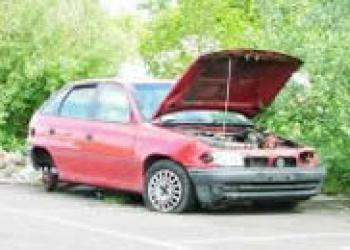
Abandoned vehicles
Abandoned vehicles can devalue an area, promoting blight and deterioration. They create fire and health and safety hazards and generally constitute a nuisance and obstruction to other road users.
| If you think a vehicle has been involved in a crime you should contact Suffolk Police on 01473 613500 or 101 or Crime Stoppers on 0800 555 111. |
How do I know that a vehicle is abandoned?
The following criteria will help decide if a vehicle may be abandoned:
- The condition of the vehicle
- The location of the vehicle in relation to the owners address
- The completeness of the vehicle
- Rusty brake discs indicating that vehicle has not been moved for some time
- Flat tyres
- Litter, weeds etc under the vehicle indicating that it has not been moved
- Absence of number plates
- Broken windscreen or window glass
- Presence of mould on either the inside or outside of the vehicle
Are all untaxed vehicles abandoned?
No, most untaxed vehicles are in regular use, and cannot be considered abandoned.
It is illegal to keep a vehicle with no current vehicle excise duty on the road. It is the responsibility of the DVLA to follow through on untaxed vehicles.
You can report or check them on the GOV.UK website.
Where the owner takes responsibility for a vehicle, we will not normally deem it as abandoned.
How do I report an abandoned vehicle?
You can report an abandoned vehicle online, by calling Customer Services or in person at any of the councils' offices.
What happens after the vehicle is reported?
A Council Enforcement Officer will inspect the vehicle and investigate whether it is actually abandoned. If in the opinion of the Enforcement Officer the vehicle is abandoned then the course of action that will be taken by the Council is dependent on the condition and location of the vehicle:
- Vehicles that have been designated as "abandoned and only fit for destruction" These vehicles will be taken straight to an Authorised Treatment Facility (ATF). The decision on whether a vehicle is only fit for destruction or not will be based on the age, condition and market value of the vehicle, and whether or not the vehicle has a registered keeper. The ATF will treat the vehicle as an end of life vehicle and produce a Certificate of Destruction (CoD). The ATF will keep one copy of the CoD and the Council will hold the other copy.
- Vehicles that have been designated as "abandoned and not only fit for destruction" These vehicles will be stored for 7 days at a secure storage facility whilst reasonable efforts are made to trace the registered keeper or owner of the vehicle. If the vehicle is not claimed after 7 days the vehicle will be taken to an ATF for its disposal or disposed of as the Council sees fit. Once an owner has come forward and proved that they are the owner or keeper of the vehicle they will have a further 7 days to collect their vehicle at an additional cost of the prescribed daily storage fee.
- Vehicles abandoned on privately owned land Are subject to a notice period. A 15-Day Notice to Remove Vehicle will be served on the landowner or occupier. The Vehicle will remain in situ for 15 days unless the landowner/ land occupier gives the Council their permission to remove the vehicle. If the landowner or occupier objects to the removal of the vehicle then the Council can no longer treat the vehicle as an abandoned vehicle.
Once this permission from the landowner/ occupier to remove the vehicle has been received the 15-Day Notice automatically lapses. The vehicle can then be removed from the privately owned land immediately. The Council's aim will be to remove the vehicle within 24 hours from this point in time (excluding weekends and bank holidays) to an ATF or a storage facility for 7 days depending on its condition."
What happens if it is decided that the vehicle is abandoned?
Any vehicle that is clearly abandoned becomes the responsibility of the Council. The law governing the removal of vehicles is contained in the Road Traffic Regulation Act 1984, the Refuse Disposal (Amenity) Act 1978 and the Removal and Disposal of Vehicle Regulations 1986.
Is abandoning a vehicle a criminal offence?
Yes, under section 2(1) of the 1978 Act. The maximum penalty for abandoning a vehicle is a fine or 3 months imprisonment or both.
Who is responsible for the vehicle and costs involved?
There is no charge for the person reporting a vehicle but the council will always try to trace the last known owner to recover costs. The last registered owner is responsible for the disposal of a vehicle if it is inspected and deemed abandoned. We will pursue them via the DVLA for reimbursement of costs. If they tell us that the vehicle was sold, they must provide details of the new owner. Failure to do so will render the last registered owner responsible. You must by law inform the DVLA of any change of ownership or disposal of the vehicle and ensure you keep all documentation. The Council will take action to recover the statutory charges for its removal, storage and disposal from the person responsible for abandoning a vehicle.
I have an old car that I need to scrap – what can I do with it?
Free vehicle take back
Under the End of Life Vehicle Directive, car manufacturers have set up Authorised Treatment Facilities (ATFs) to scrap complete old cars when they reach the end of their life. You can now deliver your unwanted vehicle to certain sites or arrange for it to be picked up and taken for disposal, depending on the make of your vehicle.
To find the details of your nearest ATF, contact one of the two national end-of-life vehicle take-back schemes, CarTakeBack or Rewarding Recycling.







